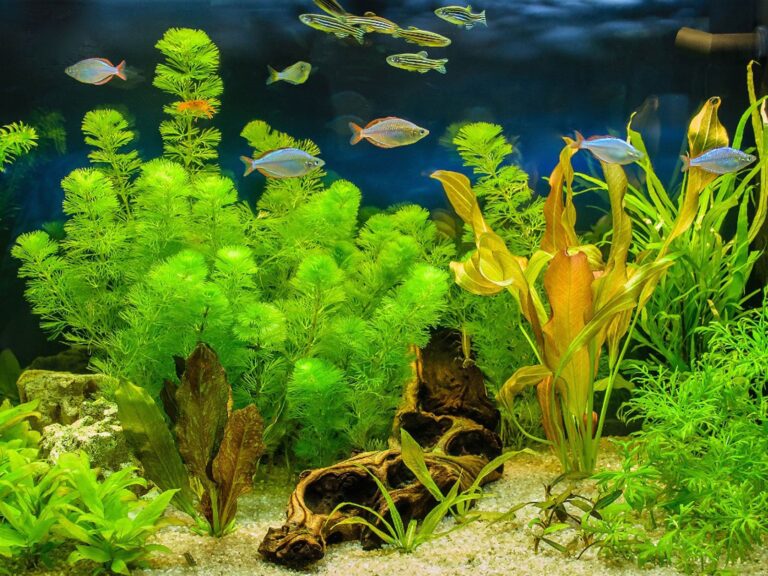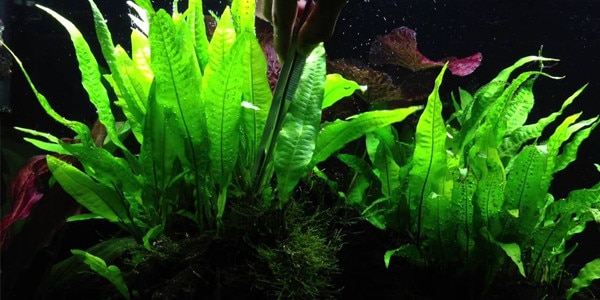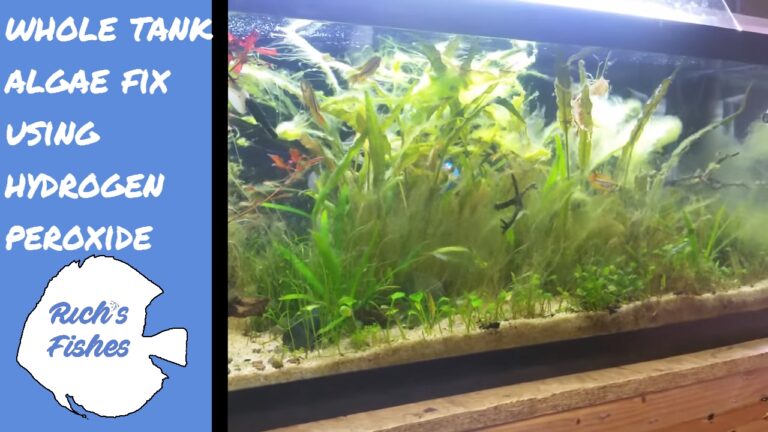How to Start a Planted Aquarium: A Beginner’s Guide
To start a planted aquarium, choose a suitable tank and substrate, then add appropriate lighting and plants. Ensure proper water conditions for plant growth.
Starting a planted aquarium can be a rewarding hobby that brings a piece of nature into your home. Begin by selecting a tank size that fits your space and budget. Use a nutrient-rich substrate to support plant roots and growth.
Adequate lighting is crucial for photosynthesis, so invest in good-quality LED lights. Choose a variety of aquatic plants that suit your skill level, from easy-to-care-for species like Java fern to more demanding ones like carpeting plants. Regular maintenance, such as trimming and water changes, keeps your planted aquarium healthy and thriving. This setup creates a balanced ecosystem for fish and plants alike.

Credit: sevenports.com
Introduction To Planted Aquariums
Starting a planted aquarium can be a rewarding hobby. It adds beauty to your home and provides a healthy environment for fish. Planted aquariums mimic natural habitats, making them ideal for fish and plants.
Benefits Of A Planted Aquarium
Planted aquariums offer many benefits. Here are some key advantages:
- Improved Water Quality: Plants absorb toxins, keeping water clean.
- Natural Habitat: Plants create a natural home for fish.
- Oxygen Production: Plants release oxygen, which is vital for fish.
- Reduced Algae Growth: Plants compete with algae for nutrients, reducing algae growth.
- Aesthetic Appeal: A well-planted tank looks beautiful and serene.
Common Myths
There are some myths about planted aquariums. Here are a few:
- Myth: Planted tanks are hard to maintain. Reality: With basic knowledge, they are easy to care for.
- Myth: You need expensive equipment. Reality: Basic gear works fine for most beginners.
- Myth: Fish will eat all the plants. Reality: Most fish coexist well with plants.
Choosing The Right Tank
Starting a planted aquarium begins with choosing the right tank. This decision sets the stage for your aquatic plants and fish to thrive. Here, we will focus on Tank Size and Material Options to help you make an informed choice.
Tank Size
The size of your tank is crucial. It impacts the health of your plants and fish. Below are some common tank sizes:
- Small Tanks: 5-10 gallons, ideal for beginners.
- Medium Tanks: 20-30 gallons, good for a variety of plants.
- Large Tanks: 50 gallons or more, best for advanced setups.
A larger tank offers more stability. It also provides more room for plants and fish. For beginners, a 20-gallon tank is a balanced choice. It’s easier to maintain and provides enough space for various species.
Material Options
Choosing the right material for your tank is also important. The two main options are glass and acrylic. Each has its pros and cons:
| Material | Pros | Cons |
|---|---|---|
| Glass |
|
|
| Acrylic |
|
|
For a clearer view and affordability, glass tanks are great. Acrylic tanks are better if you need a lightweight and durable option. The choice depends on your needs and budget.
Essential Equipment
Starting a planted aquarium can be rewarding and beautiful. To ensure success, you need the right equipment. This section covers the essential tools needed for a thriving planted aquarium.
Lighting Systems
Light is crucial for plant growth in an aquarium. It mimics natural sunlight and helps plants perform photosynthesis. Choose a lighting system that suits your aquarium size and plant types.
- LED Lights: Energy-efficient and customizable. Ideal for all aquarium sizes.
- Fluorescent Lights: Affordable and effective. Suitable for low to moderate light plants.
- Metal Halide Lights: Best for large tanks. Provides strong light for high-demand plants.
Ensure your lighting system provides the correct spectrum. Aim for lights that offer full-spectrum or plant-specific wavelengths. Adjust the duration of light exposure. Most plants need 8 to 12 hours of light daily.
Filtration Options
Filtration keeps your aquarium clean and healthy. It removes waste, toxins, and debris from the water. Choose a filter that matches your tank size and type of plants.
- Hang-on-Back (HOB) Filters: Easy to install and maintain. Suitable for small to medium tanks.
- Canister Filters: Powerful and efficient. Ideal for larger tanks with heavy planting.
- Sponge Filters: Gentle and affordable. Perfect for small tanks and shrimp setups.
Consider using a filter with adjustable flow rates. Plants prefer gentle water movement. Strong currents can uproot or damage delicate plants. Regular maintenance is crucial. Clean or replace filter media as needed.
Substrate Selection
Choosing the right substrate is crucial for a planted aquarium. It affects plant growth, water chemistry, and the aquarium’s overall aesthetic. In this section, we will explore different substrate types and nutrient-rich options to help you make an informed decision.
Types Of Substrate
There are several types of substrates available for planted aquariums. Each type has its own benefits and drawbacks. Here are the most common types:
- Gravel: Gravel is durable and easy to clean. It comes in various sizes and colors.
- Sand: Sand provides a natural look. It is soft but can compact over time.
- Clay-Based: Clay substrates are rich in nutrients. They support strong root growth.
- Aquasoil: Aquasoil is designed specifically for planted tanks. It has high nutrient content.
Nutrient-rich Options
For healthy plant growth, nutrient-rich substrates are essential. These substrates contain minerals and nutrients that plants need. Here are some popular nutrient-rich options:
| Substrate | Key Nutrients | Benefits |
|---|---|---|
| Fluval Stratum | Minerals, trace elements | Enhances root development, stabilizes pH |
| Eco-Complete | Iron, calcium, magnesium | Supports strong plant growth, easy to use |
| Seachem Flourite | Iron | Promotes healthy roots, long-lasting |
Consider these factors when selecting your substrate. The right choice ensures a thriving planted aquarium.
Picking The Right Plants
Starting a planted aquarium can be an exciting journey. One of the most crucial steps is picking the right plants. Choosing the right plants ensures a balanced and healthy environment for your aquatic life. Whether you are a beginner or an experienced aquarist, selecting the right plants can make or break your aquarium’s success.
Beginner-friendly Plants
If you are new to planted aquariums, start with beginner-friendly plants. These plants are easy to care for and can thrive in various conditions.
- Java Fern: Low light, attaches to rocks and driftwood.
- Anubias: Hardy, low light, slow-growing.
- Amazon Sword: Thrives in medium light, fast-growing.
- Java Moss: Great for beginners, attaches to surfaces.
- Hornwort: Floats or can be planted, grows quickly.
Advanced Options
For those with more experience, consider advanced plant options. These plants require specific conditions but offer stunning visuals.
| Plant | Light Requirements | CO2 Needs |
|---|---|---|
| Dwarf Baby Tears | High Light | High CO2 |
| Rotala Rotundifolia | Medium to High Light | Medium CO2 |
| Monte Carlo | Medium to High Light | Medium CO2 |
| Red Tiger Lotus | Medium Light | Low to Medium CO2 |
| Staurogyne Repens | Medium Light | Medium CO2 |
These plants need higher light levels and CO2 injection. They reward the effort with vibrant colors and intricate forms.

Credit: www.youtube.com
Setting Up The Tank
Starting a planted aquarium can be an exciting project. The first step is setting up the tank. This ensures a healthy environment for your plants and fish. Let’s dive into the details.
Planting Techniques
Choosing the right planting techniques is crucial for your aquarium’s success. Here are some techniques to consider:
- Foreground Plants: These are small plants that grow near the front.
- Midground Plants: These plants grow in the middle section.
- Background Plants: These are tall plants that grow at the back.
Each plant type needs specific care. Make sure to place them correctly for balanced growth.
Water Cycling
Water cycling is essential for maintaining a healthy aquarium. It involves establishing a nitrogen cycle. This process breaks down harmful toxins. Here is a simple guide:
- Fill the tank with water.
- Add a water conditioner.
- Introduce beneficial bacteria.
- Monitor ammonia, nitrite, and nitrate levels.
- Wait until levels stabilize before adding fish.
Regularly check water parameters to ensure a stable environment.
| Plant Type | Placement | Care Tips |
|---|---|---|
| Foreground | Front | Trim regularly |
| Midground | Middle | Moderate light |
| Background | Back | High light |
Following these steps ensures a thriving planted aquarium. Happy planting!
Maintaining Your Aquarium
Setting up a planted aquarium is just the beginning. Proper maintenance ensures your plants thrive. Regular care keeps your aquarium healthy and beautiful. Let’s explore the essential tasks for maintaining your aquarium.
Regular Maintenance Tasks
Regular maintenance is crucial for a thriving aquarium. Here are some tasks to keep in mind:
- Water Changes: Change 10-20% of the water weekly.
- Testing Water: Test pH, ammonia, nitrite, and nitrate levels weekly.
- Cleaning the Glass: Use an algae scraper to clean the glass.
- Pruning Plants: Trim dead leaves and overgrown plants.
- Checking Equipment: Ensure filters, heaters, and lights are working well.
Dealing With Algae
Algae can be a common issue in planted aquariums. Here are some tips to manage algae growth:
- Control Lighting: Limit light exposure to 8-10 hours daily.
- Maintain Water Quality: Regular water changes help control algae.
- Add Algae Eaters: Introduce algae-eating fish or snails.
- Use Fertilizers Wisely: Avoid over-fertilizing, which can boost algae growth.
- Manual Removal: Remove visible algae using a scraper or brush.
Common Issues And Solutions
Starting a planted aquarium can be exciting and rewarding. Yet, you might face several common issues. Understanding these problems and their solutions can ensure a thriving aquatic ecosystem.
Plant Health Problems
Healthy plants are crucial for a vibrant aquarium. Here are some common plant health problems and their solutions:
- Yellowing Leaves: This often indicates a lack of nutrients. Consider adding a liquid fertilizer.
- Holes in Leaves: This may be due to potassium deficiency. Use a potassium supplement.
- Algae Overgrowth: Too much light can cause algae. Reduce the lighting period or intensity.
Water Quality Issues
Water quality is vital for both plants and fish. Address these common water quality issues:
| Issue | Solution |
|---|---|
| High Ammonia Levels | Perform regular water changes. Use ammonia-removing products. |
| Low pH Levels | Add a pH buffer to stabilize the water. |
| Cloudy Water | Check the filter. Clean or replace it if necessary. |
Enjoying Your Planted Aquarium
Setting up a planted aquarium is just the beginning. The real joy is in watching it thrive. A well-maintained aquarium is a beautiful addition to any space. Follow these tips to ensure your tank remains vibrant and healthy.
Creating A Balanced Ecosystem
A balanced ecosystem is key to a healthy aquarium. Here are some crucial steps to achieve this:
- Choose the right plants: Opt for a mix of foreground, midground, and background plants.
- Maintain proper lighting: Ensure your plants get the right amount of light.
- Use quality substrate: A nutrient-rich substrate supports plant growth.
- Monitor water parameters: Regularly check pH, ammonia, nitrite, and nitrate levels.
- Introduce beneficial bacteria: This helps break down waste and keeps water clean.
Tips For Long-term Success
Maintaining a planted aquarium requires ongoing care. Follow these tips for long-term success:
- Regular water changes: Change 20-30% of the water weekly.
- Trim plants regularly: This encourages new growth and prevents overcrowding.
- Feed fish sparingly: Overfeeding can lead to excess waste and algae growth.
- Monitor algae growth: Use algae eaters and control light exposure.
- Fertilize appropriately: Use liquid or root fertilizers as needed.
By following these steps, you can enjoy a lush, healthy planted aquarium. The beauty of a thriving aquarium is unmatched. Happy aquascaping!

Credit: www.youtube.com
Frequently Asked Questions
What Do I Need To Start A Planted Aquarium?
To start a planted aquarium, you need a tank, substrate, plants, lighting, and a filtration system. Choose suitable plants and ensure proper water conditions.
How Do I Choose Aquarium Plants?
Choose aquarium plants based on their light requirements, growth rate, and compatibility with your tank inhabitants. Research each plant’s needs.
How Often Should I Change Water In A Planted Tank?
Change 10-20% of the water every week. This helps maintain water quality and nutrient balance, promoting healthy plant growth.
What Type Of Substrate Is Best For Planted Aquariums?
Use nutrient-rich substrates like aqua soil or gravel mixed with root tabs. These provide essential nutrients for plant roots and support healthy growth.
Conclusion
Creating a planted aquarium is rewarding and enjoyable. Follow these steps to ensure a thriving underwater garden. Choose the right plants and maintain proper water conditions. Regular maintenance and care will keep your aquarium beautiful. Start your planted aquarium journey today and enjoy the serene beauty it brings.




